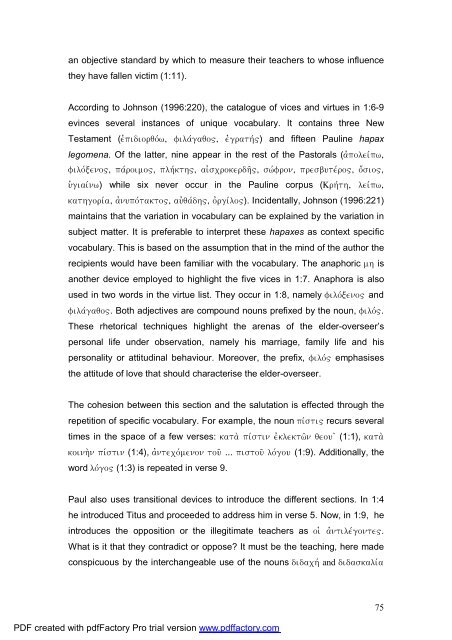A Text centred rhetorical analysis of Paul's Letter to Titus
A Text centred rhetorical analysis of Paul's Letter to Titus
A Text centred rhetorical analysis of Paul's Letter to Titus
Create successful ePaper yourself
Turn your PDF publications into a flip-book with our unique Google optimized e-Paper software.
an objective standard by which <strong>to</strong> measure their teachers <strong>to</strong> whose influence<br />
they have fallen victim (1:11).<br />
According <strong>to</strong> Johnson (1996:220), the catalogue <strong>of</strong> vices and virtues in 1:6-9<br />
evinces several instances <strong>of</strong> unique vocabulary. It contains three New<br />
Testament (ejpidiorqovw, filavgaqo", ejgrathv") and fifteen Pauline hapax<br />
legomena. Of the latter, nine appear in the rest <strong>of</strong> the Pas<strong>to</strong>rals (ajpoleivpw,<br />
filovxeno", pavroimo", plhvkth", aijscrokerdh'", swvfron, presbutevro", o{sio",<br />
uJgiaivnw) while six never occur in the Pauline corpus (Krhvth, leivpw,<br />
kathgoriva, ajnupovtak<strong>to</strong>", aujqavdh~, ojrgivlo"). Incidentally, Johnson (1996:221)<br />
maintains that the variation in vocabulary can be explained by the variation in<br />
subject matter. It is preferable <strong>to</strong> interpret these hapaxes as context specific<br />
vocabulary. This is based on the assumption that in the mind <strong>of</strong> the author the<br />
recipients would have been familiar with the vocabulary. The anaphoric mh is<br />
another device employed <strong>to</strong> highlight the five vices in 1:7. Anaphora is also<br />
used in two words in the virtue list. They occur in 1:8, namely filovxeno~ and<br />
filavgaqo~. Both adjectives are compound nouns prefixed by the noun, filov".<br />
These <strong>rhe<strong>to</strong>rical</strong> techniques highlight the arenas <strong>of</strong> the elder-overseer’s<br />
personal life under observation, namely his marriage, family life and his<br />
personality or attitudinal behaviour. Moreover, the prefix, filov" emphasises<br />
the attitude <strong>of</strong> love that should characterise the elder-overseer.<br />
The cohesion between this section and the salutation is effected through the<br />
repetition <strong>of</strong> specific vocabulary. For example, the noun pivsti" recurs several<br />
times in the space <strong>of</strong> a few verses: kata; pivstin ejklektw`n qeou` (1:1), kata;<br />
koinh;n pivstin (1:4), ajntecovmenon <strong>to</strong>u` ... pis<strong>to</strong>u` lovgou (1:9). Additionally, the<br />
word lovgo" (1:3) is repeated in verse 9.<br />
Paul also uses transitional devices <strong>to</strong> introduce the different sections. In 1:4<br />
he introduced <strong>Titus</strong> and proceeded <strong>to</strong> address him in verse 5. Now, in 1:9, he<br />
introduces the opposition or the illegitimate teachers as oiJ ajntilevgonte".<br />
What is it that they contradict or oppose? It must be the teaching, here made<br />
conspicuous by the interchangeable use <strong>of</strong> the nouns didachv and didaskaliva<br />
PDF created with pdfFac<strong>to</strong>ry Pro trial version www.pdffac<strong>to</strong>ry.com<br />
75

















